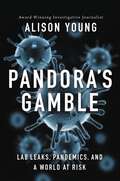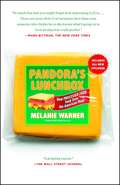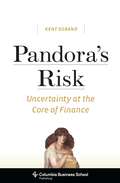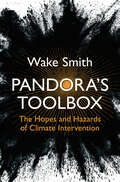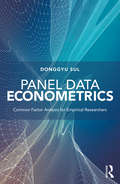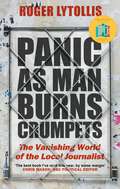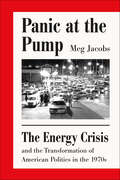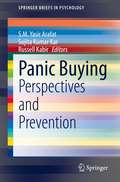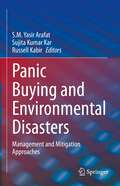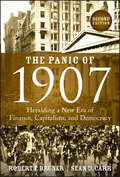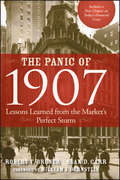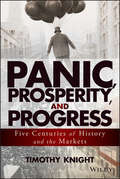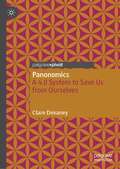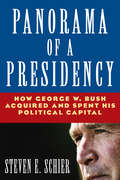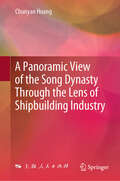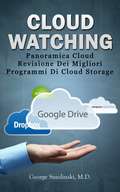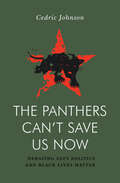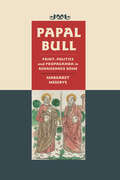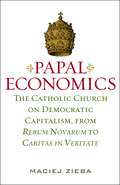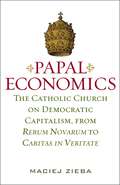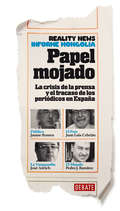- Table View
- List View
Pandora's Gamble: Lab Leaks, Pandemics, and a World at Risk
by Alison YoungNamed to Kirkus Reviews&’ Best Books of 2023 A &‘remarkable book.&’ – The New York TimesThis fearless, deeply reported book about laboratory accidents asks the haunting question some elite scientists don&’t want the public to entertain: Did the COVID-19 pandemic start with a lab leak in Wuhan, China? This is an obvious question. Yet there&’s been an extraordinary effort by government officials in China, as well as leading scientific experts in the United States and around the world, to shut down any investigation or discussion of the lab leak theory. In private, however, some of the world&’s elite scientists have seen a lab accident as a very real and horrifying possibility. They know what the public doesn&’t. Lab accidents happen with shocking frequency. Even at the world&’s best-run labs. That&’s among the revelations from Alison Young, the award-winning investigative reporter who has spent nearly 15 years uncovering shocking safety breaches at prestigious U.S. laboratories for USA Today and other respected news outlets. In Pandora&’s Gamble, Young goes deep into the troubling history -- and enormous risks -- of leaks and accidents at scientific labs. She takes readers on a riveting journey around the world to some of the worst lab mishaps in history, including the largely unknown stories of the lab workers at the U.S. Army&’s Camp Detrick who suffered devastating infections at alarming rates during World War II. And her groundbreaking reporting exposes for the first time disturbing new details about recent accidents at prestigious laboratories – and the alarming gaps in government oversight that put all of us at risk. Sourced through meticulous reporting and exclusive interviews with key players including Dr. Anthony Fauci, former CDC Director Tom Frieden and others, Young&’s examination reveals that the only thing rare about lab accidents is the public rarely finds out about them. Because when accidents happen, powerful people and institutions often work hard to keep the information secret.
Pandora's Lunchbox: How Processed Food Took Over the American Meal
by Melanie WarnerIn the tradition of Fast Food Nation and The Omnivore's Dilemma a fascinating and cutting-edge look at the scary truth about what really goes into our food. If a piece of individually wrapped cheese retains its shape, color, and texture for years, what does it say about the food we eat and feed our children? Former New York Times business reporter and mother Melanie Warner decided to explore that question when she observed the phenomenon of the indestructible cheese. She began an investigative journey that takes her to research labs, food science departments, and factories around the country. What she discovered provides a rare, eye-opening--and sometimes disturbing--account of what we're really eating. Warner looks at how decades of food science have resulted in the cheapest, most abundant, most addictive, and most nutritionally devastating food in the world, and she uncovers startling evidence about the profound health implications of the packaged and fast foods that we eat on a daily basis.From breakfast cereal to chicken subs to nutrition bars, processed foods account for roughly 70 percent of our nation's calories. Despite the growing presence of farmers' markets and organic produce, strange food additives are nearly impossible to avoid. Combining meticulous research, vivid writing, and cultural analysis, Warner blows the lid off the largely undocumented--and lightly regulated--world of chemically treated and processed foods and lays bare the potential price we may pay for consuming even so-called "healthy" foods.
Pandora’s Risk: Uncertainty at the Core of Finance (Columbia Business School Publishing)
by Kent OsbandAuthor of the acclaimed work Iceberg Risk: An Adventure in Portfolio Theory, Kent Osband argues that uncertainty is central rather than marginal to finance. Markets don't trade mainly on changes in risk. They trade on changes in beliefs about risk, and in the process, markets unite, stretch, and occasionally defy beliefs. Recognizing this truth would make a world of difference in investing. Belittling uncertainty has created a rift between financial theory and practice and within finance theory itself, misguiding regulation and stoking huge financial imbalances.Sparking a revolution in the mindset of the investment professional, Osband recasts the market as a learning machine rather than a knowledge machine. The market continually errs, corrects itself, and makes new errors. Respecting that process, without idolizing it, will promote wiser investment, trading, and regulation. With uncertainty embedded at its core, Osband's rational approach points to a finance theory worthy of twenty-first-century investing.
Pandora's Toolbox: The Hopes and Hazards of Climate Intervention
by Wake SmithReaching net zero emissions will not be the end of the climate struggle, but only the end of the beginning. For centuries thereafter, temperatures will remain elevated; climate damages will continue to accrue and sea levels will continue to rise. Even the urgent and utterly essential task of reaching net zero cannot be achieved rapidly by emissions reductions alone. To hasten net zero and minimize climate damages thereafter, we will also need massive carbon removal and storage. We may even need to reduce incoming solar radiation in order to lower unacceptably high temperatures. Such unproven and potentially risky climate interventions raise mind-blowing questions of governance and ethics. Pandora's Toolbox offers readers an accessible and authoritative introduction to both the hopes and hazards of some of humanity's most controversial technologies, which may nevertheless provide the key to saving our world.
Panel Data Econometrics: Common Factor Analysis for Empirical Researchers
by Donggyu SulIn the last 20 years, econometric theory on panel data has developed rapidly, particularly for analyzing common behaviors among individuals over time. Meanwhile, the statistical methods employed by applied researchers have not kept up-to-date. This book attempts to fill in this gap by teaching researchers how to use the latest panel estimation methods correctly. Almost all applied economics articles use panel data or panel regressions. However, many empirical results from typical panel data analyses are not correctly executed. This book aims to help applied researchers to run panel regressions correctly and avoid common mistakes. The book explains how to model cross-sectional dependence, how to estimate a few key common variables, and how to identify them. It also provides guidance on how to separate out the long-run relationship and common dynamic and idiosyncratic dynamic relationships from a set of panel data. Aimed at applied researchers who want to learn about panel data econometrics by running statistical software, this book provides clear guidance and is supported by a full range of online teaching and learning materials. It includes practice sections on MATLAB, STATA, and GAUSS throughout, along with short and simple econometric theories on basic panel regressions for those who are unfamiliar with econometric theory on traditional panel regressions.
Panic as Man Burns Crumpets: The Vanishing World of the Local Journalist
by Roger Lytollis'For those who know about provincial newspapers, this will be a classic and a gem. Those who don't know will envy what they have missed' MELVYN BRAGG'Brisk and entertaining. A very readable love letter to a disappearing world, told with verve and tenderness' STUART MACONIE, author of Pies and Prejudice'Gut-bustingly funny, poignant and packed with astonishing insider information'M. W. CRAVEN, author of the award-winning The Puppet ShowYou dreamed of being a journalist and the dream has come true. You love working for your local paper . . . although not everything is as you imagined.You embarrass yourself with a range of celebrities, from John Hurt to Jordan. Your best story is 'The Man With the Pigeon Tattoo'.A former colleague interviews President Trump. You urinate in the president of the Mothers' Union's garden. Your appearance as a hard-hitting columnist on a BBC talk show does not go well. And being photographed naked is only the second most humiliating thing to happen one infamous afternoon. There are serious stories, such as a mass shooting, a devastating flood, and the search for Madeleine McCann.Meanwhile local papers are dying. Your building is crumbling and your readership is dwindling. Your carefully crafted features are read by fewer people than a story about fancy dress for dogs. Panic as Man Burns Crumpets is the inside story of local newspapers during the past twenty-five years, told in a way that's funny, poignant and revealing.
Panic as Man Burns Crumpets: The Vanishing World of the Local Journalist
by Roger Lytollis'For those who know about provincial newspapers, this will be a classic and a gem. Those who don't know will envy what they have missed' MELVYN BRAGG'Brisk and entertaining. A very readable love letter to a disappearing world, told with verve and tenderness' STUART MACONIE, author of Pies and Prejudice'Gut-bustingly funny, poignant and packed with astonishing insider information'M. W. CRAVEN, author of the award-winning The Puppet Show'Local journalism has never seemed more exotic than in this part-memoir, part-ode to that disappearing art, which is as funny as it is endearing . . . Told with a tender fondness, the bonkers, baffling but vital world of local press is paraded with the style that it deserves'JONATHAN WHITELAW, Sun'Refreshingly honest, engagingly self-deprecating, tremendously funny and more than a little heartbreaking. By far my favourite read of the year so far'MIKE WARD, TV editor, Daily Express/Daily Star 'Local publishers . . . need to hold on to thoughtful, dedicated writers such as Roger Lytollis, or his book will be an epitaph to a centuries-old industry'IAN BURRELL, i paper'Anyone who has ever worked at a local newspaper, or wondered what it is like, should read this book'DOMINIC PONSFORD, media editor at New Statesman Media Group/editor-in-chief at Press Gazette'[Lytollis] writes with clarity, comically self-effacing honesty and surprising poignancy . . . [this is] the story of what it is like to love what you do, and be great at it, and to watch it collapse around you in slow motion' ROBYN VINTER, GuardianYou dreamed of being a journalist and the dream has come true. You love working for your local paper . . . although not everything is as you imagined.You embarrass yourself with a range of celebrities, from John Hurt to Jordan. Your best story is 'The Man With the Pigeon Tattoo'.A former colleague interviews President Trump. You urinate in the president of the Mothers' Union's garden. Your appearance as a hard-hitting columnist on a BBC talk show does not go well. And being photographed naked is only the second most humiliating thing to happen one infamous afternoon. There are serious stories, such as a mass shooting, a devastating flood, and the search for Madeleine McCann.Meanwhile local papers are dying. Your building is crumbling and your readership is dwindling. Your carefully crafted features are read by fewer people than a story about fancy dress for dogs. Panic as Man Burns Crumpets is the inside story of local newspapers during the past twenty-five years, told in a way that's funny, poignant and revealing.
Panic at the Pump: The Energy Crisis and the Transformation of American Politics in the 1970s
by Meg JacobsAn authoritative history of the energy crises of the 1970s and the world they wroughtIn 1973, the Arab OPEC cartel banned the export of oil to the United States, sending prices and tempers rising across the country. Dark Christmas trees, lowered thermostats, empty gas tanks, and the new fifty-five-mile-per-hour speed limit all suggested that America was a nation in decline. “Don’t be fuelish” became the national motto. Though the embargo would end the following year, it introduced a new kind of insecurity into American life—an insecurity that would only intensify when the Iranian Revolution led to new shortages at the end of the decade.As Meg Jacobs shows, the oil crisis had a decisive impact on American politics. If Vietnam and Watergate taught us that our government lied, the energy crisis taught us that our government didn’t work. Presidents Nixon, Ford, and Carter promoted ambitious energy policies that were meant to rally the nation and end its dependence on foreign oil, but their efforts came to naught. The Democratic Party was divided, with older New Deal liberals who prized access to affordable energy squaring off against young environmentalists who pushed for conservation. Meanwhile, conservative Republicans argued that there would be no shortages at all if the government got out of the way and let the market work. The result was a political stalemate and panic across the country: miles-long gas lines, Big Oil conspiracy theories, even violent strikes by truckers.Jacobs concludes that the energy crisis of the 1970s became, for many Americans, an object lesson in the limitations of governmental power. Washington proved unable to design an effective national energy policy, and the result was a mounting skepticism about government intervention that set the stage for the rise of Reaganism. She offers lively portraits of key figures, from Nixon and Carter to the zealous energy czar William Simon and the young Donald Rumsfeld and Dick Cheney. Jacobs’s absorbing chronicle ends with the 1991 Gulf War, when President George H. W. Bush sent troops to protect the free flow of oil in the Persian Gulf. It was a failure of domestic policy at home that helped precipitate military action abroad. As we face the repercussions of a changing climate, a volatile oil market, and continued turmoil in the Middle East, Panic at the Pump is a necessary and lively account of a formative period in American political history.
Panic Buying: Perspectives and Prevention (SpringerBriefs in Psychology)
by S. M. Yasir Arafat Sujita Kumar Kar Russell KabirThis brief provides a thorough overview of the history and underlying motivations for consumer panic buying, evaluating psychological perspectives on this behavior on both an individual and societal level. The first volume of its kind to focus specifically on the topic of panic buying, the book situates its analysis within the context of the modern COVID-19 pandemic as well as in a broader psychology context. Chapters encompass a variety of interdisciplinary perspectives, incorporating insights from consumer psychology, marketing, sociology, and public health. Finally, contributors discuss the long-term implications of panic buying and potential prevention strategies. Panic Buying: Perspectives and Prevention will be a useful reference for researchers and students in consumer psychology, as well as those interested emergency preparedness, and supply chain management. First volume of its kind to focus specifically on the consumer behavior of panic buyingAnalyzes panic buying behavior in the context of the modern COVID-19 pandemic as well as within a broader psychology contextProvides a multidisciplinary analysis of panic buying, including perspectives from consumer psychology, social psychology, marketing, emergency preparedness, and public health.
Panic Buying and Environmental Disasters: Management and Mitigation Approaches
by S. M. Yasir Arafat Sujita Kumar Kar Russell KabirPanic buying is a common response during crises; however, to date it has been a significantly under-researched area. Recent evidence suggests that an environmental stimulus, such as the COVID-19 pandemic, war, earthquakes, flooding, public health emergencies (SARS, MARS) can trigger this phenomenon. As an environmental crisis takes its toll, the understanding of panic buying becomes overlooked. Nevertheless, panic buying causes series of events separate from these primary events. Understanding the management of emergencies and disasters should be an integral part of dealing with panic buying since every major environmental crisis has the potential to initiate panic buying behaviour in the general public. This book will analyse episodes of panic buying and major environmental crisis focusing on specific prevention strategies. This book is the first of its kind of approach to join up the management of panic buying during a public health emergency.
The Panic of 1907: Heralding a New Era of Finance, Capitalism, and Democracy
by Robert F. Bruner Sean D. CarrAn authoritative "biography" of one of history's great financial crises with enduring lessons about contemporary finance In this newly-revised second edition, offering 50% entirely new material, The Panic of 1907: Heralding a New Era of Finance, Capitalism, and Democracy, delivers a groundbreaking examination of one of the most consequential crises in financial history. Deftly weaving historical evidence, insightful analysis, and compelling narrative, The Panic of 1907 explains how and why a financial panic unfolds, with lessons that can be applied to our understanding of present-day financial and monetary systems. In the book, you'll find: The reasons why, despite today's stronger monetary regime and risk-mitigation tools, our modern institutions are not immune to future crises Explanations about the development of the United States' Federal Reserve System, which was created in 1913 in direct response to the Panic of 1907 An engaging and entertaining account of an innately fascinating period in financial and economic history, with remarkable leaders and a gallery of rogues An indispensable tale that belongs on the shelves of anyone with an interest in American or financial history, The Panic of 1907 is an expert retelling of one of the most important, but least well-known crises of the last 200 years.
The Panic of 1907: Lessons Learned from the Market's Perfect Storm
by Robert F. Bruner Sean D. Carr"Before reading The Panic of 1907, the year 1907 seemed like a long time ago and a different world. <P><P>The authors, however, bring this story alive in a fast-moving book, and the reader sees how events of that time are very relevant for today's financial world. In spite of all of our advances, including a stronger monetary system and modern tools for managing risk, Bruner and Carr help us understand that we are not immune to a future crisis." --Dwight B. Crane, Baker Foundation Professor, Harvard Business School "Bruner and Carr provide a thorough, masterly, and highly readable account of the 1907 crisis and its management by the great private banker J. P. Morgan. Congress heeded the lessons of 1907, launching the Federal Reserve System in 1913 to prevent banking panics and foster financial stability. We still have financial problems. <P>But because of 1907 and Morgan, a century later we have a respected central bank as well as greater confidence in our money and our banks than our great-grandparents had in theirs." --Richard Sylla, Henry Kaufman Professor of the History of Financial Institutions and Markets, and Professor of Economics, Stern School of Business, New York University "A fascinating portrayal of the events and personalities of the crisis and panic of 1907. Lessons learned and parallels to the present have great relevance. Crises and panics are as much a part of our future as our past." --John Strangfeld, Vice Chairman, Prudential Financial "Who would have thought that a hundred years after the Panic of 1907 so much remained to be written about it? Bruner and Carr break significant new ground because they are willing to do the heavy lifting of combing through massive archival material to identify and weave together important facts. Their book will be of interest not only to banking theorists and financial historians, but also to business school and economics students, for its rare ability to teach so clearly why and how a panic unfolds." --Charles Calomiris, Henry Kaufman Professor of Financial Institutions, Columbia University, Graduate School of Business
Panic, Prosperity, and Progress: Five Centuries of History and the Markets (Wiley Trading)
by Timothy KnightA detailed guide to financial market performance during financial crises With the financial markets seemingly careening from one crisis to another, it's vital for today’s investors and traders to have an historical perspective on market performance during times of great turmoil. In this book, Tim Knight provides an exhaustive analysis of financial market behavior prior, during, and following tumultuous events since 1600. Making copious use of charts and basic technical analysis, Knight demonstrates how external shocks tend to create extreme reactions in the financial markets and how these predictable reactions provide opportunities for investors and traders to profit. Knight traverses five centuries of financial market history, from Tulipmania in the 1600s to the contemporary sovereign debt crisis. He looks at each event from the prism of the financial markets, examining the market climate prior to the event, during the event, and following the event. Draws essential lessons from history providing investors and traders with guidelines to better navigate markets in today's tumultuous times Offers valuable insights on understanding and anticipating market responses to shocks and crises Companion website with a Q&A section contains charts from key moments in past financial crises and asks readers to choose whether to go long, short, or step aside If you're looking for a better way to make it today's dynamic markets, look no further than this timely book.
Panonomics: A 4.0 System to Save Us from Ourselves
by Clare DevaneyThis book presents a vision for a new and holistic organisational system and paradigm—panonomics. Panonomics proposes a comprehensive understanding of ‘place’ and an expansive understanding of ‘time’ as the foundational framework for a new system. Presented as a fitting response to a pandemic and in support of progress through the 4.0 age, panonomics asserts an onward and upward directionality towards a shared mission of human survival and planetary sustainability, characterised as the continuous accumulation of time. While ambitious in both scope and proposals, the book sets out a theoretical context and framework, modelling how the principles of panonomics can be applied to current and emerging policy and asserting that, through expanding and extending our understandings of key concepts such as place, time and innovation, we can break free from the confines of current and regressive economic structures, systems and institutions to reset, reframe and advance collectively towards a ‘future now’.
Panorama of a Presidency: How George W. Bush Acquired and Spent His Political Capital
by Steven E SchierAs the controversial presidency of George W. Bush draws to a close, this work provides the first dispassionate, even-handed assessment of Bush's years in office. Widely respected scholar and author Steven E. Schier goes beyond the perspective of contemporary political commentary, and draws on wide-ranging literature about presidential history and strategy to carefully identify both the unique and the familiar aspects of George W. Bush's presidency. "Panorama of a Presidency" examines Bush's innovative electoral and governing strategies, ambitious foreign and domestic policy initiatives, and the bitterly divisive consequences of his mode of governance. As the first analysis to place the George W. Bush presidency in a broad historical and theoretical context, the book will be an essential foundation for any future studies on the topic.
A Panoramic View of the Song Dynasty Through the Lens of Shipbuilding Industry
by Chunyan HuangThis book examines the impact of shipbuilding on the society of the Song Dynasty from multiple perspectives and points out the positive contribution of ancient manufacture industry to social development at that time. It explores some virgin territories and presents strong originality, such as the inland navigation methods in the Song Dynasty, the system of gods and goddesses in the aquatic world, and the defense system of the Yangtze River and the sea in the Southern Song Dynasty. It includes the markets in the coastal areas, the perception and imagery of the sea, the maritime disasters and rescues, the river courses and sea warfare, and the management of private ships in the Song Dynasty. On top of that, it provides fresh analysis and new perspectives on some issues that have been studied, such as Lisheng, shapes and sizes of ships, and vehicles and ships in the Song Dynasty.
Panoramica Cloud
by George Smolinski Arabela SoloneanDescrizione del libro: Hai bisogno di un modo migliore per organizzare la tua vita. Questo libro ti farà vedere come! Negli ultimi dieci anni, le rivoluzioni tecnologiche hanno permesso di migliorare drasticamente la velocità e l'efficienza con cui operiamo. Una rivoluzione importante è stato l'avvento del cloud storage, che consente la memorizzazione di documenti, file, video, foto e altro ancora nel "cloud". Non più abbiamo bisogno di mantenere i file sul computer o in armadi, per ora possiamo semplicemente metterli in questi programmi di cloud storage con un semplice clic del mouse. Insieme a tutte le nuove tecnologie, le domande sorgono sempre su quale programma è migliore, ha la massima funzionalità, ed è il più sicuro. Questo libro risponde a queste domande per i primi programmi di cloud storage oggi disponibili: 1. Google Drive 2. Evernote 3. Dropbox 4. Amazon Cloud Drive 5. Microsoft OneDrive In questo libro, troverete informazioni dettagliate su questi programmi, così come alcuni consigli utili su come massimizzare l'utilizzo di Google Drive e troverete anche i dettagli su altri programmi top come Evernote e gli elementi essenziali Evernote di cui avete bisogno per massimizzare tale piattaforma. Alla fine delle recensioni di singoli programmi, offro un confronto punto per punto di questi programmi di cloud storage e le mie raccomandazioni finali. Cloud storage è qui per rimanere, è un modo efficace per massimizzare la produttività e liberare la vostra vita. Comprando questo libro, prenderete una decisione su quali programmi di cloud storage utilizzare, e sbloccare questa tecnologia per voi!
Pantheon Ventures in 2019
by Victoria Ivashina Tonia LabruyereThe case discusses the strategy of Pantheon, a UK-based fund of funds investing in private equity. Client demands and preferences had changed in the aftermath of the 2008 global financial crisis and Pantheon had to adapt its business model to accommodate requests for new asset classes and customized portfolios. The challenge was to keep an eye on the fee structure, as clients also put pressure on the costs. Pantheon had extended its offer into infrastructure, real assets, and private debt, and had found a way to offer customized portfolio solutions at an acceptable cost level, but the very long-term nature of private asset classes was making it difficult to assess the success of this strategic turnaround.
The Panthers Can't Save Us Now: Debating Left Politics and Black Lives Matter
by Cedric JohnsonEnding the horrors of police violence requires addressing economic inequalityIn the wake of the mass protests following the police murder of George Floyd nearly every major consumer brand had proclaimed their commitments to antiracism, often with new ad campaigns to match their tweets. Very little in the way of police reform has been achieved. Still less was achieved around policies that might help the millions of black Americans living at or below the poverty line. Why has anti-racism been such a powerful source of mobilization but such a poor means of building political opposition capable of winning big reforms? This volume revisits a debate that transpired during Black Live Matter&’s first wave. Writing against the grain of popular left sentiments, Johnson cautions against a new ethnic politics. Instead, he calls for broad-based left politics as the only viable means for ending the twin crises of racial inequality and police violence. Redistribution, public goods, and multi-ethnic working-class solidarity are the only viable response to the horrors of police violence and mass incarceration. It just so happens that fighting the conditions that make crime and violence inevitable is also the means by which we can build a working-class majority and a more equal and peaceful nation.
Papal Bull: Print, Politics, and Propaganda in Renaissance Rome (Singleton Center Books in Premodern Europe)
by Margaret MeserveHow did Europe's oldest political institution come to grips with the disruptive new technology of print?Printing thrived after it came to Rome in the 1460s. Renaissance scholars, poets, and pilgrims in the Eternal City formed a ready market for mass-produced books. But Rome was also a capital city—seat of the Renaissance papacy, home to its bureaucracy, and a hub of international diplomacy—and print played a role in these circles, too. In Papal Bull, Margaret Meserve uncovers a critical new dimension of the history of early Italian printing by revealing how the Renaissance popes wielded print as a political tool. Over half a century of war and controversy—from approximately 1470 to 1520—the papacy and its agents deployed printed texts to potent effect, excommunicating enemies, pursuing diplomatic alliances, condemning heretics, publishing indulgences, promoting new traditions, and luring pilgrims and their money to the papal city. Early modern historians have long stressed the innovative press campaigns of the Protestant Reformers, but Meserve shows that the popes were even earlier adopters of the new technology, deploying mass communication many decades before Luther. The papacy astutely exploited the new medium to broadcast ancient claims to authority and underscore the centrality of Rome to Catholic Christendom. Drawing on a vast archive, Papal Bull reveals how the Renaissance popes used print to project an authoritarian vision of their institution and their capital city, even as critics launched blistering attacks in print that foreshadowed the media wars of the coming Reformation. Papal publishing campaigns tested longstanding principles of canon law promulgation, developed new visual and graphic vocabularies, and prompted some of Europe's first printed pamphlet wars. An exciting interdisciplinary study based on new literary, historical, and bibliographical evidence, this book will appeal to students and scholars of the Italian Renaissance, the Reformation, and the history of the book.
Papal Economics
by Maciej Zieba"For a long time to come, this book may well be the definitive work on the economic teaching of the modern popes." --MICHAEL NOVAKThe Catholic Church has long been one of the most important--but least understood--authorities on capitalism and democracy.The confusion and controversy didn't begin with Pope Francis. For well over a century popes have offered profound reflections on the economic and political order in their social encyclicals. But this estimable intellectual tradition has often been misunderstood, with partisan groups variously proclaiming Catholic social teaching to be left-wing or right-wing, pro-socialist or pro-capitalist or even pro-"third way."Papal Economics corrects the record. Father Maciej Zieba's incisive analysis shows that the Church displays a profound understanding of democracy and--perhaps more surprising--strong support for free markets. As Father Zieba demonstrates, popes have explicitly rejected socialism while praising a democratic state and market economy.Of course, this praise is not unqualified. Papal Economics shows how the Church, especially through John Paul's teachings, distinguishes true democracy from false, and praiseworthy capitalism from the kind to be rejected. Moving beyond the narrow confines of secular discourse, Catholic social teaching highlights the dangers that arise when the market and the state are elevated to absolutes in themselves--when man's spiritual dimensions are subordinated to his material ones. Ultimately, anyone who cares about free markets and democracy must understand, and defend, the foundations on which they are built. For as John Paul suggested, in a world without truth, freedom loses its meaning, the market loses its efficiency, and democracy yields to statism.
Papal Economics: The Catholic Church on Democratic Capitalism, from Rerum Novarum to Caritas in Veritate
by Maciej ZiebaPapal Economics corrects the record about one of the most important—but least understood—authorities on capitalism and democracy: the Catholic Church. Maciej Zieba, OP—a leading interpreter of the thought of Pope John Paul II—takes readers on an enlightening tour through the Catholic Church&’s social teaching on economics and governance. Examining papal pronouncements from the late nineteenth century to the present, Zieba shows that the Church displays a profound understanding of democracy and support for free markets. But this praise is not unqualified—a major reason why secular commentators of all stripes misinterpret Catholic social teaching. Updated with a brand-new afterword explaining the controversial economic teachings of Pope Francis, Papal Economics is the essential book for understanding the proper path forward.
Papel mojado: Reality News/mongolia
by MongoliaUn extraordinario ensayo sobre la crisis de la prensa y el fracaso de los periódicos en España. En los últimos años, la combinación de una crisis económica sin precedentes y el advenimiento de la era digital han creado una tormenta perfecta que parece haber herido de muerte a la prensa escrita, sin que ningún periódico esté a salvo, desde los diarios gratuitos hasta las cabeceras más prestigiosas. Sin embargo, achacar a factores externos esta situación sería deshonesto; muchas decisiones equivocadas y estrategias suicidas han contribuido. La habitual opacidad de los medios a la hora de informar sobre sí mismos ha permitido mantener esos errores ocultos. Afortunadamente, la aparición de Mongolia, un medio nuevo e irreverente sin las ataduras del pasado, ha cambiado el escenario. Desde su sección «Reality news», Mongolia ha prestado singular atención a esta cuestión, vital para cualquier sociedad libre. Papel mojado recoge todo lo publicado e incorpora material nuevo e inédito.
Paper and More (A)
by Noel WatsonProvides a context and exercise for introducing retail inventory management, including cost optimization, service-level criteria, and forecasting in single and multiproduct settings. The owner of a single-location paper and paper products store considers the implications of expansion for inventory management. Considerations include lost sales, retail metrics for multiproduct settings, and shelf space constraints.
Paper and the British Empire: The Quest for Imperial Raw Materials, 1861–1960 (Routledge Explorations in Economic History)
by Timo SärkkäPaper and the British Empire examines the evolution of the paper industry within British organisational frameworks and highlights the role of the Empire as a market and business-making area in a world of shrinking commerce and rising trade barriers. Drawing on a valuable range of primary sources, this book covers the period 1861–1960 and examines events from the establishment of free trade backed by the gold standard to Britain’s membership of the European Free Trade Association. In the field of the paper industry, the speed and intensity of the industrialisation process around the globe have been shaped by a wide variety of variables, including the surrounding institutional framework; entrepreneurial and organisational strategies; the cost and accessibility of transport; and the availability of capital, knowledge, energy resources, and technology. The supply of papermaking raw materials has also been key and has historically been the most important determinant for geographical location and dominance. The research in this work focuses on the roles played by such variants, on the one hand, and demand characteristics on the other. In particular, it considers developments connected to a quest for Empire-grown raw materials in order to tackle the problem of the lack of indigenous raw materials and the resulting dependence on Scandinavian wood pulp imports. This text is of considerable interest to advanced students and researchers in economic history, business history, and the paper industry, and will also be useful to organisations working within the pulp and paper industries.
